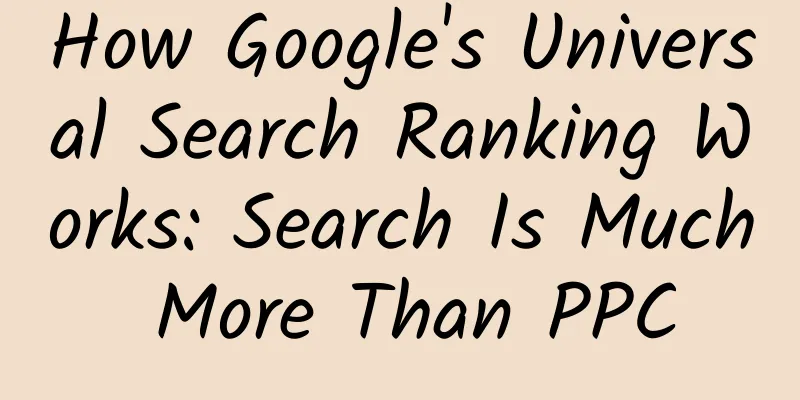How Google's Universal Search Ranking Works: Search Is Much More Than PPC

IntroductionSince Google introduced the universal search function in 2007, the content of search engine results pages (SERPs) has become increasingly rich. Many businesses use SERPs to make their websites rank higher and more prominently on Google search pages. The secrets behind Google’s algorithm and its ranking factors have long been the subject of heated debate. Most of the time, the results were just 10 blue links, and the debate centered on inbound links and keyword density. In hindsight, it seems like a “low-profile” debate from an age of innocence. Universal Search: Lighting the Torch of GoogleGoogle began injecting other elements into its search engine with the introduction of Universal Search in 2007. "We're trying to break down the silos that have traditionally separated various search attributes and bring together the vast amount of available information into a simple set of search results," said Marissa Mayer, the company's first product manager, at the time. Google has indeed been moving in this direction. Since 2007, the SERPs have become increasingly richer and now include a large number of verticals - images, videos, news, jobs, maps, etc. A question people should probably ask is, “How exactly does Google determine which elements appear in the SERPs?” Jason Barnard, an expert in SERP optimization and management, began to think about this question when he started studying SERPs in 2013. He quickly mastered the elements of the 10 blue links, and it was difficult to include knowledge panels, video boxes, Twitter boxes, and other rich elements at the time. The question then is: what triggers them? What algorithmic triggers need to be “triggered” for these SERP Features to appear? Finally, in 2019, Google technical expert Gary Illyes explained the mechanics of universal search to Jason Barnard and many Australian SEOs. Importantly, Bing has confirmed that their universal search functionality is implemented in much the same way (some insights shared by Bing’s Nathan Chalmers echo Barnard), with Gary Illyes saying: “This is not a Google-specific feature. Other engines do this as well, because most search engines rank results in pretty much the same way… This probably applies to every search engine.” Universal search ranking: How it works1. What are the ranking factors?There are many factors that influence website rankings, perhaps as many as 200. But nowadays, things are even more complicated because algorithms are driven by machine learning. Search Engine Journal has published a helpful guide that breaks down this complex topic into 88 chapters. John Mueller pointed out that Google's ranking factors already exceed these 200. Google groups them into: topicality, quality, page speed, RankBrain, entities, structured data, freshness…. A few points need to be pointed out here:
Google calculates a score for a piece of content for each ranking factor: It’s important to remember that these numbers in this article are completely hypothetical. 2. How ranking factors affect biddingGoogle takes the individual ranking factor scores and combines them to calculate the total bid. Importantly, the total bid is calculated by multiplying these scores together: The total score is capped at 2^64 (although this is not 100% true, this is a reference to the math problem with the wheat and the chessboard, where the number the chessboard came up with was wildly off range, and is actually a fail-safe buffer). This means that these scores could be in single, double, triple, or even quadruple digits, and the total would never reach that cap. Such a high cap also means Google can continue to throw in more factors without having to "bump" existing scores to make room for new ones. 3. Algorithm authenticity: low scores kill biddingThe fact that the total bid is calculated by multiplication is a surprising discovery. Why? Because any score below 1 will severely affect its bid, no matter what the other scores are. Take a look at the numbers below to see how much of an impact this has. Because just one factor with a score below 1 is enough to make the page uncompetitive. While a ranking factor below 1 can be overcome with other factors, the other factors need to be very strong. Therefore, ignoring weak factors is a bad strategy, while working hard to get this factor above 1 is a good strategy. Therefore, the examples of “SEO” corrections that one often sees in the SEO industry are often sites “simply” correcting a ranking factor that was below 1 point. The system rewards pages with high scores across the board. Pages that perform well in some factors but poorly in others will always be at a disadvantage. A balanced approach will win. An industry expert put this in a good analogy when explaining, “A student with all Cs is better than a student with 3 As and 1 F.” 4. “Pay-for-ranking”Example of Google's auction-based ranking 5. Optimize the bidding for the final rankingThe top results (say 10) are sent to the next algorithm, which is designed to refine the ranking and remove any unacceptable results that slipped through. The factors taken into account here are different and case-specific. This recalculation can raise or lower the bid (or conceivably keep it the same). Therefore, the following final bid set needs to be studied. Note that in this example, one of the results received a score of 0, so it is not considered or excluded at all (because it is multiplicative, any 0 score will ensure that the total score is also 0). This is very radical. Such 0 can be generated by algorithms. Barnard's guess is that 0 can also be used as a way to implement some artificial operations. Sure enough, the order changed, and there was a final list of web results/“10 blue links.” The end result was still very pleasing. "Candidate result set": the battle for the element's succession1. Candidate result sets compete for the position on the search engine homepageEach type of result/rich element is effectively competing for the first page spot. News, Images, Videos, Featured Snippets, Carousels, Maps, GBP, etc. – each one offers a list of candidates for the homepage and their bids. There are already many businesses vying to be on the front page, and the list is constantly growing. With this system, there is, in theory, no limit to the number of rich elements Google can create. 2. Candidate ranking factorsThe terms "candidate result" and "candidate result set" come from Jason Barnard, not from Google. The combination of factors that influence the ranking among these candidate result sets must be specific to each factor, as some factors are unique to a single candidate result set and some factors are not applicable. For example, alt tags apply to the image candidate set but not to the other sets, or a news sitemap applies to the news candidate set but not to the calculation for the other sets. 3. Weight of ranking factors of candidate result setFor each candidate result set, the relative weight of each factor is necessarily different because each factor provides a specific type of information in a specific format. Its purpose is to provide the user with the most appropriate elements:
For example, freshness will be an important factor in news, while RankBrain and MUM are important factors in featured snippets. 4. Candidate result set bidding calculationThe bid offered by each candidate set is calculated in the same way as in the first network/blue link example (via multiplication, assuming the second refinement algorithm is used). Google has multiple candidates bidding on one place on the page (or several places, depending on the type). Put all your content together on the search page homepage (1) Candidate result sets bid against each otherGoogle is simply looking for any rich results that offer a “better” solution to the user. It wants to provide SERPs that will lead its users to the best solutions to their problems, or answer their questions as efficiently as possible. The rules Jason Barnard used to make these winning selections are fictional and not what Google actually uses. When it does identify a "better" candidate result, that result is given a position (at the expense of one or more traditional blue links). (2) The final “end” of the rich elements on the homepageEach candidate result set is subject to certain constraints and is subject to the traditional presentation of results: blue links.
As positions are given rich elements, lower-ranked web results drop to the second page. As more rich elements are added to the SERPs, they tend to be visually dominant, so blue links gradually lose their importance. Blue links aren’t going away anytime soon, but they are becoming less and less visible on the SERPs. Interestingly, even Jason Barnard said he didn't know how the location was attributed to the video or image information because he got the location using a simple system he developed rather than Google's system. To the future: SEO evolution never stopsData from Kalicube Pro shows that the average number of blue links on the SERPs is fairly stable, but the number of common features is increasing. Below is a snapshot view showing that the average number of SERP rich elements (SERP features) for a business increased from 1.5 to 2.5 in one year. Generic searches increasingly dominate SERPs and should be a bigger concern for SEOs. Generic search results now visually dominate most SERPs, and traditional blue links are getting fewer and fewer clicks. This is a concern for traditional SEO strategies, so you need to adapt and look at the bigger picture. Universal search relies on non-text elements like images, videos, maps, questions, social channels, etc., so businesses need to develop these formats and integrate them into their strategy to gain better visibility on Google (or Bing) SERPs. Not only that, but since Twitter, YouTube, and other third-party platforms tend to dominate generic results on SERPs, you need to consider integrating them more tightly into your SEO strategy. It can be said that off-page SEO has never been more important than it is now. |
<<: Is iOS's power saving mode actually a gaming mode? An in-depth analysis gives you the answer
>>: Kotlin 1.8 will completely remove Kotlin Synthetics
Recommend
Tencent Weibo is officially closed: Currently unable to log in, users can apply for personal content backup
On September 29, at 23:59 last night, Tencent Wei...
Tips for promoting Internet products on Zhihu!
Today I would like to share with you my experienc...
APK Slimming Notes: How to Achieve a 53% Compression Effect
[[164861]] 1. How do I think about this matter? A...
Advertising creative ecology sinks
About seven or eight years ago, a friend who ran ...
Customizing a Line Chart with SwiftUI Charts in iOS 16
SwiftUI charts, introduced in iOS 16, can present...
Chengdu Tea Selection Studio, a great place to drink and taste tea
Appointment arrangements for Chengdu Tea Tasting ...
What is the value of B-side designers? Let’s take a look at the director-level analysis (Part 1)
Where does the value of B-side designers come fro...
Practical operation! How to promote APP and acquire users?
Everyone who works in the Internet industry needs...
How does a brand do marketing? If Apple sells apples, would you buy them? ?
Let’s first look at two interesting marketing hyp...
360 search display advertising promotion process, product advantages introduction, and concept explanation!
What are display ads? Display advertising is a wi...
How much does it cost to be a beer agent? How much can a county-level beer agent earn in a year?
You can call Snow Flake's manufacturer in Han...
Reveal the secrets of making money on short video platforms that you don’t know about, and help you easily master short videos!
Reveal the secrets of making money on short video...
A must-read for entrepreneurs: How long does it take to develop an App?
[[219589]] With an estimated 350 billion mobile a...
2021 New Consumer Brand Digitalization Report
China has become the world's second largest c...
User Activation: Breaking Down Luckin Coffee’s New User Activation Process
There are many ways to attract new customers to y...


![[In-depth Analysis] How to create information flow advertising materials for adult education?](/upload/images/67cc2d040feb1.webp)






